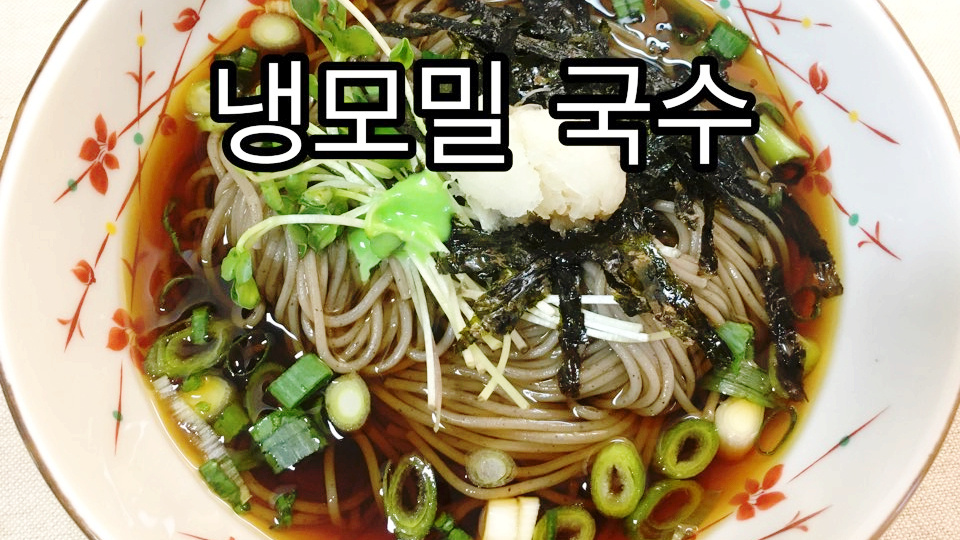Refreshing Cold Soba Noodles
How to Make Cold Soba Noodles and Tsuyu Sauce: The Ultimate Summer Dish with Buckwheat Noodles.

I made cold soba noodles using Pyeongchang buckwheat noodles. The homemade soba sauce is incredibly delicious, unlike store-bought tsuyu.
Ingredients- 2 servings Buckwheat noodles
- 100g Daikon radish
- A little Radish sprouts
- 1 Scallion
Tsuyu Sauce- 1 cup Soy sauce
- 1/2 cup Sugar
- 1/3 cup Mirin (sweet rice wine)
- 1/2 cup Water
- 20g Ginger (sliced)
- 10g Katsuobushi (bonito flakes)
- 1 sheet Kombu (kelp)
- 10g Anchovies (for broth)
- 1 Scallion (cut into large pieces)
- 1 cup Soy sauce
- 1/2 cup Sugar
- 1/3 cup Mirin (sweet rice wine)
- 1/2 cup Water
- 20g Ginger (sliced)
- 10g Katsuobushi (bonito flakes)
- 1 sheet Kombu (kelp)
- 10g Anchovies (for broth)
- 1 Scallion (cut into large pieces)
Cooking Instructions
Step 1
First, for the sauce, cut the daikon radish into large chunks. Also, cut the onion into large pieces. These will be simmered in the sauce.

Step 2
Cut the scallion for the tsuyu sauce into large pieces as well. Small pieces might disintegrate during cooking.

Step 3
*Ideally, these vegetables are grilled over an open flame. However, since I used an electric stove, I opted for the air fryer. Roast the chopped vegetables in the air fryer at 200°C (392°F) for 15 minutes. This enhances their natural sweetness.

Step 4
On a dry pan over medium heat, lightly toast the anchovies to remove any fishy odor. I used medium-sized anchovies and toasted them with the guts still inside. If using large anchovies, it’s best to remove the guts to avoid bitterness. (Tip: Microwaving for 1 minute 30 seconds can also help eliminate fishiness.)

Step 5
Once the anchovies are toasted, add the kombu, soy sauce, mirin, sugar, sliced ginger, the roasted vegetables, and water to a pot. Bring to a simmer. Start on high heat, then reduce to medium heat and let it gently simmer.

Step 6
As it simmers, remove the kombu halfway through. Continue simmering over medium heat until the sauce has reduced by half. This concentration deepens the flavor.

Step 7
When the sauce has reduced by half and is boiling, turn off the heat and add the katsuobushi. Let it steep for about 5 minutes to infuse its umami flavor.

Step 8
Strain the cooled sauce through a fine-mesh sieve, pressing down gently to extract every last drop of the flavorful liquid. Using cheesecloth can help achieve an even cleaner strained sauce.

Step 9
Once the tsuyu sauce has cooled considerably, cover it with plastic wrap and place it in the freezer to chill thoroughly. It’s even better if it develops a slight icy layer. Your tsuyu sauce is now complete!

Step 10
While the sauce is chilling, finely chop the scallion for garnish. Grate the daikon radish using a fine grater.

Step 11
Gently squeeze the grated daikon radish with your hands, not to remove all the water, but just enough to get a fluffy texture, similar to cotton. Don’t squeeze it completely dry, as it might become too mushy.

Step 12
Wash the radish sprouts and set aside. Portion out a small amount of shredded seaweed (gim) for garnish.

Step 13
Bring a pot of water to a rolling boil and add the buckwheat noodles. As the water starts to boil over, add a splash of cold water to calm it down. Repeat this process three times. This method ensures the noodles are cooked perfectly, similar to cooking somen noodles.

Step 14
Once the noodles are cooked, immediately rinse them under cold running water to firm up the texture and drain them well.

Step 15
Mix the chilled tsuyu sauce with an equal amount of cold water (1:1 ratio) to create the cold soba broth. (You can adjust the water ratio to your preference. Using a small ladle to mix allows for easier adjustment.)

Step 16
Place the drained soba noodles in a bowl. Top with the chopped scallions, fluffy grated daikon radish, radish sprouts, and shredded seaweed. Serve with a dollop of karashi (Japanese mustard) if desired. (If you prefer a milder heat, use tube-type yellow mustard.) For an extra refreshing experience, add a few ice cubes to the bowl.




